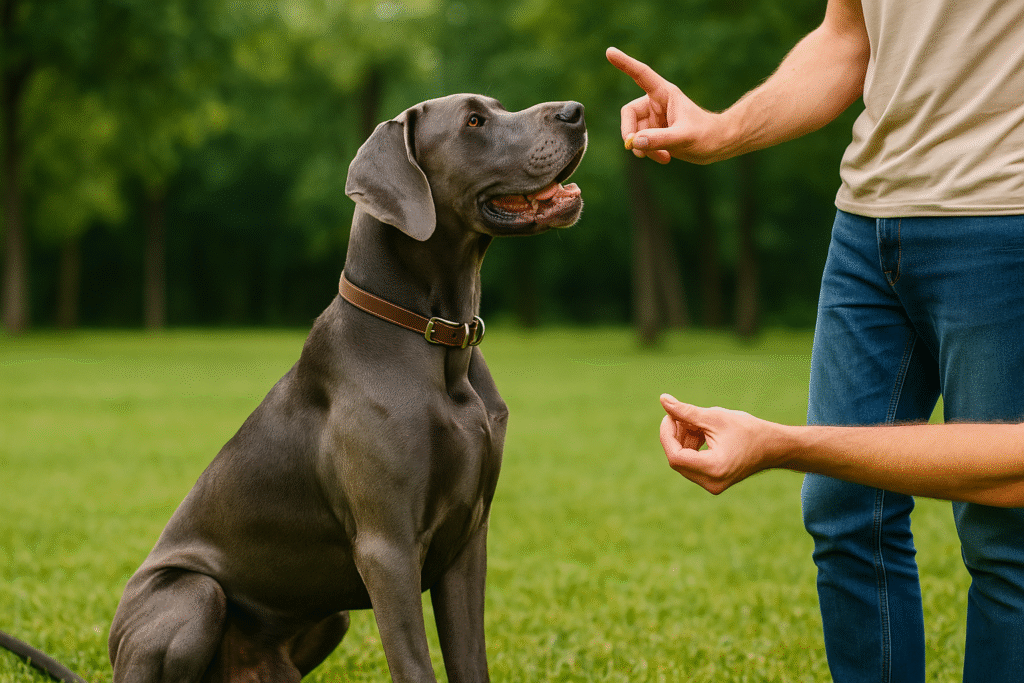The Great Dane Care Guide covers everything you need to know about this gentle giant—from personality and temperament to training, health needs, and grooming. Learn how to provide the best lifestyle, nutrition, and preventive care to ensure your Great Dane thrives with love and proper guidance.
Introduction: Why a Great Dane Care Guide Matters
The Great Dane Care Guide is essential for owners who want to raise one of the largest dog breeds in the world. Known as “gentle giants,” Great Danes combine an impressive size with a calm, affectionate temperament. Despite their majestic appearance, they require careful attention to training, diet, exercise, and health monitoring.

Great Dane Personality & Temperament
One of the most defining aspects of a Great Dane Care Guide is understanding their personality. These dogs are gentle, affectionate, and known for their loyalty. They thrive in family environments and bond closely with their owners.
Gentle Giants
Despite their massive size, Great Danes are calm and even-tempered. They are protective yet rarely aggressive, making them excellent companions for families with children.
Affectionate & Loyal
Great Danes are affectionate “lap dogs” who often underestimate their size. They are loyal, protective, and love spending time with their families.
Training Needs for Great Danes
Training is a vital part of this Great Dane Care Guide. Due to their size, proper training is necessary from an early age.
Early Socialization
Socializing your Great Dane with people, children, and other pets helps prevent fear-based aggression and ensures they grow into well-mannered adults.
Basic Obedience Training
Commands such as sit, stay, and recall are crucial. Because of their strength, untrained behavior can quickly become overwhelming.
Leash Training
Leash walking must begin early. Great Danes are strong pullers, so consistent training avoids future issues. For tips, read our guide on Loose Leash Walking.

Exercise Requirements
A balanced exercise routine is another highlight of this Great Dane Care Guide. Despite their large size, they are not overly energetic, but regular activity is needed to maintain health.
- Daily walks (30–60 minutes)
- Gentle playtime (avoid rough jumps to protect joints)
- Spacious yard for stretching and movement
Nutrition & Feeding Guidelines
Nutrition is critical in any Great Dane Care Guide. Their size makes them prone to specific dietary needs and risks such as bloat (gastric dilatation-volvulus).
High-Quality Diet
Choose large-breed dog food with controlled protein and fat levels. Balanced calcium and phosphorus are essential for bone health.
Feeding Schedule
Provide multiple small meals daily instead of one large meal to reduce the risk of bloat.
Grooming & General Care
While Great Danes have short coats, they still need regular grooming to stay healthy and comfortable.
- Weekly brushing to reduce shedding
- Monthly baths or as needed
- Routine ear cleaning and nail trimming
Common Health Needs
The Great Dane Care Guide must address their unique health issues. They are prone to several conditions due to their size and genetics.
Bloat (GDV)
Bloat is a life-threatening condition common in large breeds. Feeding smaller meals and avoiding vigorous activity after eating helps reduce risk. Learn more from PetMD on Bloat.
Hip Dysplasia
This joint condition requires weight management and sometimes supplements such as glucosamine and chondroitin.
Heart Disease
Dilated cardiomyopathy is another concern. Regular vet checkups and early screenings are recommended.
Living With a Great Dane
Living with a Great Dane means adapting your home. They require space to move comfortably and a strong commitment to health care due to their shorter lifespan (7–10 years).
Family Environment
Great Danes are best suited for families who can dedicate time, space, and love. They are gentle with children and protective of their households.
Apartment Living?
Although possible, it requires consistent walks, training, and indoor space to accommodate their size.

FAQs About Great Dane Care
Are Great Danes good family dogs?
Yes, Great Danes are affectionate, protective, and excellent with children.
How much exercise does a Great Dane need?
They require at least 30–60 minutes of daily activity, but avoid strenuous exercise during puppyhood to protect developing joints.
What health issues are most common in Great Danes?
Bloat, hip dysplasia, and heart conditions are the most frequent health concerns.
Do Great Danes get along with other pets?
With proper early socialization, they can live harmoniously with other dogs and even cats.
Conclusion
Raising a Great Dane is a rewarding journey. This Great Dane Care Guide shows that with the right personality understanding, training, and health care, these gentle giants can live long, happy lives. For more breed guides, check out our detailed post on Bernese Mountain Dog Care.
CTA: Want to learn more about large dog breeds? 👉 Explore our Border Collie Care Guide here.

